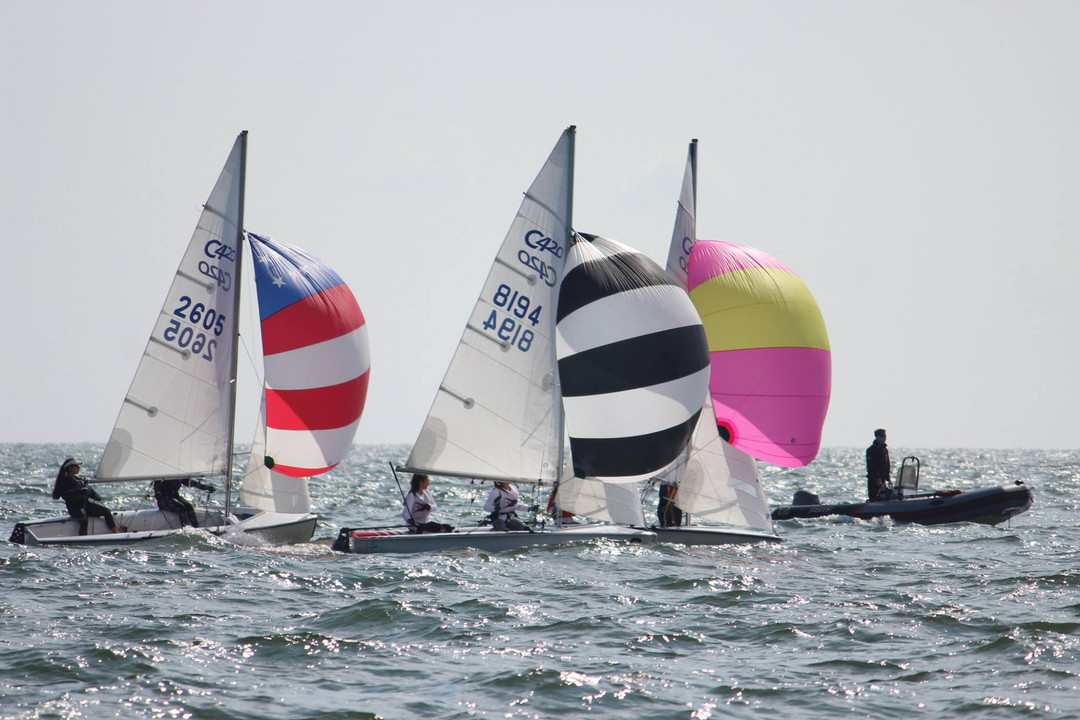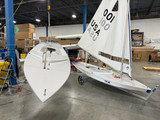Fundamentals ALL Aspiring Double-Handed Sailors Should Know
In a prior life, I did a lot of coaching and taught many US Sailing Level 1’s and 2’s (now I’m a sport psychologist). Yesterday, I did race committee for a low level varsity high school event, when breeze/waves built through the day. I had these suggestions for coaches/sailors. I share it here also, in case any nuggets might be useful to coaches on this list… (biggest hint: make sure kids know to always, always stay with the boat).
Clothing: When it’s warm out, it can be easy to get lulled into a false sense of security when it comes to clothing. But the water is cold this time of year, and weather can change quickly. Look at the forecast, including the wind forecast (using apps like SailFlow or Windy) and be ready for worst case scenarios. You would much rather be too hot and have to drink extra water then to be wet, cold, and potentially hypothermic. This late in the season, it’s worth thinking wetsuit or dry suit, even if it’s a nice sunny day. At a minimum, have that spray top tied around the base of the mast, and be ready to throw it on before the race… You won’t have a chance once you’re racing, or capsized.
Zipped/adjusted well-fitting life jacket: Your life jacket won’t do you any good, if it’s not zipped (and you can be DSQd for not really wearing it). Make sure your life jacket actually fits you… This is not something to grow into. It fits you if it is snug but not so snug that you can’t breathe… And somebody should be able to grab your shoulder straps and pull you up without it coming over your head. You also want one that isn’t so bulky, that it’s hard to get your torso above the center board if you end up in the water.
Use a pinnie: You’re supposed to use a pinnie for high school sailing anyway. One perk of a well-fitting pinnie, is that it keeps your lifejacket and whatever gear snuggly against your body and less likely to catch on stuff.
Tie your bailer and water bottle into the boat: If you capsize, you’re really not going to wanna have to chase after your bailer, water bottle, and whatever else… Tie them into the boat. An optimal way to do this, is to use a piece of shock cord (separate ones) for your baler and water bottle. Tie a figure eight knot at the end that attaches to the boat. You can tuck it under the main halyard, against the mast, such that you can manage to stretch it some and use it as needed, or you can yank it and pull it out all together and then tuck it back when you’re done.
Sail conservatively downwind in breeze: If it’s windy and wavy, you’re much better off not taking chances… Sail a higher angle, and don’t bother going wing-on-wing if you’re unstable.
Know when to accept your fate and avoid a turtle: OK, you flipped. The water is cold, and you’re not psyched… But if you want to get this over with, jump on that center board quickly. If you missed your chance, swim around the boat (lightly hanging on), rather than letting it continue to roll all the way into a turtle. Once it turtles, it’s that much more of a pain to get it up.
Right the boat by getting weight far outboard: In order to get on the centerboard, you may have to get toes against the gunwale and pull on the center board until it is parallel with the water. Once that happens, get your breath, count to three and with a big adrenaline burst - pull yourself up all the way onto that board. Once your feet are on the board, pull on the top gunwale with shoulders as far outboard as possible. If your shoulders go inward, the boat will want to turtle (and you lose progress). Sometimes, you can get both skipper and crew on the centerboard, or you can have the skipper on top while the crew is holding the middle of the board from underneath with toes against that gunwale. (Once you’re closer to righting the boat, you can swim around and grab the hiking strap as described above).
STAY WITH THE BOAT: This should be an absolute no-brainer. Under no circumstances, should you swim away from your boat. Doing so is dangerous for a multitude of reasons (e.g., it might be hard to reconnect with your boat, motorboats might not see you, and you’re increasing your time in the water). In breeze, your boat will want to drift away from you. If you are far enough away that you cannot lay a hand on the boat, you’ve gone too far. There is no reason to swim up near the sails… As the crew in the water, your ideal position is to have a hand loosely holding the skipper hiking strap, so that when the boat starts to right you can get scooped into the boat by hanging onto that strap.
Head your boat up into the wind before getting your crew in the boat: Now your boat is righted, but your crew is in the water… What are the steps to get them back in?
1) If your rudder has popped out, put it back in. You might need to do some fancy steering with the rudder not quite attached to the pintles yet. It may make life a lot easier to pull on your main get the boat to head up into the wind before messing with that rudder.
2) With rudder attached and boat now head to wind, or close to it, you can now move forward with getting your crew into the boat.
3) The crew should be amidship on the windward side. Do not try hauling them in from the back of the boat, as this can be difficult particularly if you need to do any steering (back towards head to wind).
4) If their life jacket is on properly and fits, you can pull them from their life jacket straps as they kick upward and you use your weight as if falling backward in the boat. Again it can be useful to say, “1,2,3,” and use a burst of adrenaline. Careful not to pull the hockey maneuver of getting their pinnie over their head. If lifejacket needs adjusting in the water… Then fix those straps there. Never ever consider taking lifejackets off, even if it seems like they’re getting in the way of getting on the centerboard, or onto the boat.
Happy sailing! These steps should help you stay safe, efficient, and ultimately faster on the race course.
- Tim Herzog
About the Author:
Dr. Herzog, of Reaching Ahead Counseling and Mental Performance in Annapolis, MD, is a mental performance coach and a counselor. He frequently mentors coaches and helps athletes of all ages/levels to gain mastery over anxiety. With multiple graduate degrees and years of teaching PhD students, plus knowledge as a competitor and former coach (including a stint as head Sailing coach of Boston College), Tim weaves a deep academic understanding with practical knowledge. He enjoys often assisting sailors (from Optimist through Olympic and America's Cup racers), to consistently feel and perform their best.
Advice & articles
-
Zim ISCA Lift Test - Hull Construction Improvements
13th May 2025When we were selected to be the ISCA builder, we asked the class for a list of issues that they’ve
-
Zim Sailing ISCA® Available Now
7th May 2025PRESS RELEASE - May 8th, 2025 Bristol, Rhode Island - Zim Sailing is proud to announce that product
-
2025 Spring Gear Guide
30th Jan 2025As spring sailing ramps up, it’s time to go through your gear and make sure you’re ready for anythin
- Read more articles




